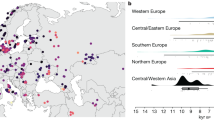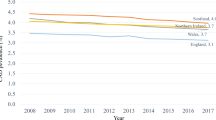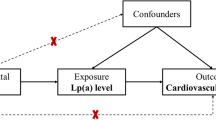Abstract
Three common alleles, ɛ 2 , ɛ 3 , and ɛ 4 , of the gene coding for apolipoprotein E (apoE) have been identified as predictors of interindividual variation in measures of lipid and lipoprotein metabolism, and ultimately risk of coronary heart disease (CHD), within many populations. Here we evaluated the utility of the geographic distribution of these alleles for prediction of interpopulation variation in average level of serum total cholesterol and other traditional risk factors, and CHD mortality rate. We employed published estimates of the relative frequencies of the three common apoE alleles, average levels of risk factors such as serum total cholesterol, systolic and diastolic blood pressure, body mass index, smoking prevalence and CHD mortality rate for nine population-based samples of middle-aged males studied by the international WHO MONICA Project. There was approximately a 10-fold difference between the highest and lowest CHD mortality rate. Of the traditional risk factors, variation in the average level of serum total cholesterol was the best predictor (approximately 33%) of the observed interpopulation variation in estimates of CHD mortality rate (Pr=0.10). Variation in the relative frequency of the ɛ 4 allele predicted approximately 50% of interpopulation variation in average serum total cholesterol level (Pr=0.02) and 75% of the variation in CHD mortality rate (Pr=0.002) when information about variation in the other risk factors and the ɛ 2 andɛ 3 alleles is ignored. Furthermore, variation in the relative frequency of the ɛ 4 allele predicted approximately 40% of the variation in CHD mortality rate (Pr=0.02) after considering the contribution of variation in average serum total cholesterol level. Average serum total cholesterol level was estimated to increase by 0.114 mmol/l (4.405 mg/dl), and CHD mortality rate by 24.5/100 000, for an increase of 0.01 in the relative frequency of the ɛ 4 allele. The predictive utility of the ɛ 2 andɛ 3 alleles was considerably less than that of the ɛ 4 allele. For the sample of populations considered, the geographic distribution of the apoE alleles can be a statistically significant predictor of interpopulation variation in both the average serum total cholesterol level and CHD mortality rate. In particular, the ɛ 4 allele may confer valuable ecological risk information.
Similar content being viewed by others
Author information
Authors and Affiliations
Additional information
Received: 2 December 1997 / Accepted: 28 May 1998
Rights and permissions
About this article
Cite this article
Stengård, J., Weiss, K. & Sing, C. An ecological study of association between coronary heart disease mortality rates in men and the relative frequencies of common allelic variations in the gene coding for apolipoprotein E. Hum Genet 103, 234–241 (1998). https://doi.org/10.1007/s004390050811
Issue Date:
DOI: https://doi.org/10.1007/s004390050811




